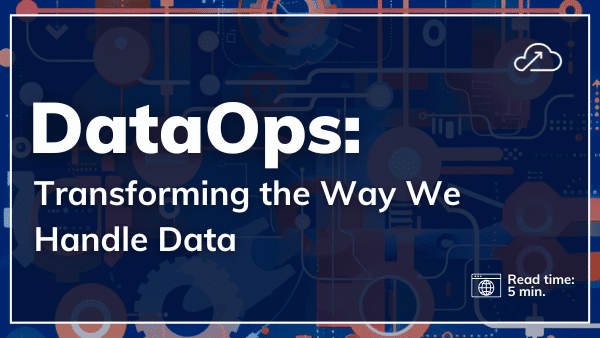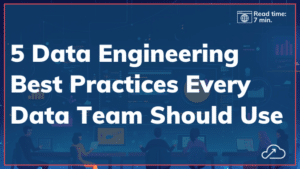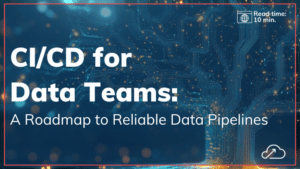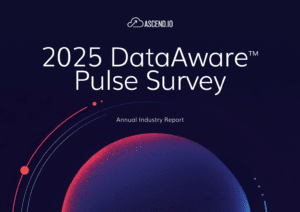6 steps to implement DataOps
1. Adopt a data product mindset
2. Set up automated pipelines
3. Continuously monitor for quality control
4. Leverage the right tools and technologies
5. Build a culture of collaboration
6. Start small, then scale
With data workflows growing in scale and complexity, data teams often struggle to keep up with the increasing volume, variety, and velocity of data.
This is where DataOps comes in—a methodology designed to streamline and automate data workflows, ensuring faster and more reliable data delivery. By adopting this approach, organizations can overcome common data management challenges and unlock the full potential of their data.
Today, we’ll break down the key benefits, best practices, and implementation strategies to enhance your data workflows with Dataops.
Let’s dive in!
What is DataOps?
DataOps, short for Data Operations, is an emerging discipline that combines data engineering, data integration, and data quality with agile methodologies and DevOps practices. The primary goal is to improve the speed, quality, and reliability of data by applying automation and orchestration to data workflows.
At its core, DataOps emphasizes collaboration, communication, and integration between data management and data analytics teams. This approach breaks down traditional data silos, allowing for continuous integration and continuous delivery (CI/CD) of data.
The result? A more agile and responsive data environment that can quickly adapt to changing business needs. Because the one constant in life is change.
The Evolution and Need for DataOps
The concept of DataOps has evolved in response to the growing complexities and demands of modern data management. Traditionally, data operations were often siloed, with different teams handling data extraction, transformation, and loading (ETL) separately from those performing data analysis and reporting.
This fragmented approach led to inefficiencies, delays, and a lack of coherence in data workflows.
Historical Context and Evolution:
- Traditional Data Management: In the past, data management processes were largely manual, with a focus on batch processing. This approach was sufficient when data volumes were smaller and less complex.
- Emergence of Big Data: The rise of big data led to a notable surge in data volume, velocity, and variety. Traditional methods struggled to keep pace with the new demands, leading to the development of more sophisticated data processing frameworks.
- Introduction of Agile and DevOps: The success of agile development methodologies and DevOps in software development highlighted the benefits of continuous integration, continuous delivery, and automation. These principles were gradually adopted in data management, giving rise to DataOps.
Why Modern Businesses Need DataOps:
- Managing Complex Data Pipelines: With data flowing from numerous sources into multiple destinations, maintaining and managing data pipelines has become increasingly complex. DataOps provides the automation and orchestration needed to handle this complexity efficiently.
- Ensuring Data Quality: Inconsistent, outdated, or inaccurate data can undermine business decisions. DataOps emphasizes continuous monitoring and quality checks throughout the data lifecycle to ensure data integrity.
- Reducing Manual Intervention: Manual processes are not only time-consuming but also prone to errors. DataOps aims to automate repetitive tasks, reducing the need for manual intervention and minimizing the risk of human error.
- Handling Growing Data Demands: Dataps leverages automation to process and analyze data in real-time, ensuring that businesses can meet these demands.
By addressing these challenges, DataOps enables organizations to harness the full potential of their data, leading to faster, more informed decision-making and a competitive edge in the market.
Key Components of DataOps
1. Automation
Automating repetitive tasks and data workflows minimizes manual intervention and reduces errors. By leveraging advanced tools and technologies, organizations can streamline processes such as data extraction, transformation, and loading (ETL).
Automation ensures consistency and speed, freeing up human resources for more strategic tasks. This not only improves efficiency but also reduces the likelihood of human error, leading to higher data quality and reliability.
2. Orchestration
Orchestration involves coordinating various data processes and systems to ensure seamless data flow. It integrates different data sources, tools, and workflows into a cohesive system that operates smoothly.
Orchestration tools manage dependencies, scheduling, and execution of data tasks, enabling a more synchronized and efficient data pipeline. This ensures that data is delivered accurately and timely, supporting real-time analytics and decision-making.
3. Continuous Integration/Continuous Delivery (CI/CD)
Applying software development practices to data management, CI/CD ensures continuous updates and improvements. CI/CD pipelines automate the integration and deployment of data changes, allowing for frequent and reliable updates.
This approach promotes rapid iteration and feedback, ensuring that data solutions evolve in response to changing business needs. It enhances agility and reduces the risk of errors during deployment.
Want to learn more about CI/CD? Check out this session from the 2023 Data Automation Summit.
4. Collaboration:
Fostering a culture of collaboration between data engineers, analysts, and other stakeholders is crucial for DataOps. Effective collaboration breaks down silos and ensures that all team members are aligned with the organization’s data goals.
Shared responsibilities and open communication channels lead to better understanding and quicker problem resolution. Collaboration tools and practices facilitate joint efforts, driving innovation and improving overall data strategy.
5. Monitoring and Quality Control:
Implementing continuous monitoring and quality checks ensures data accuracy and reliability. Monitoring tools provide real-time insights into data pipeline performance, allowing teams to detect and address issues promptly. Quality control processes, such as automated validation and error detection, maintain high data standards.
This proactive approach to data quality management ensures that the data used for decision-making is trustworthy and up-to-date.
By integrating these components, DataOps aims to create a more efficient and effective data pipeline that can support the dynamic needs of modern businesses.
5 Benefits of DataOps
Adopting DataOps can be helpful for data teams, enhancing their data management capabilities and driving better business outcomes. Here are some of the primary benefits of implementing DataOps:
1. Improved Data Quality and Reliability:
DataOps ensures data accuracy, completeness, and reliability through automated monitoring and real-time error detection, reducing the risk of inconsistencies.
2. Faster Data Delivery and Processing:
By automating routine tasks, DataOps speeds up data pipelines and enables real-time data access, allowing businesses to act on the data as it is generated.
3. Enhanced Collaboration Between Data Teams:
DataOps fosters cross-functional collaboration and shared responsibility for data quality, improving communication and alignment among data engineers, analysts, and stakeholders.
4. Scalability and Flexibility:
DataOps practices are designed to scale with the growth of data volumes and complexity. Automated and orchestrated pipelines can handle increasing amounts of data and adapt quickly to changes in data sources and business requirements without compromising performance.
5. Cost Efficiency:
Automation reduces manual intervention, freeing resources for strategic tasks, while optimized resource utilization minimizes waste and maximizes ROI in data infrastructure and tools.
Implementing DataOps in Your Organization
Successfully implementing DataOps requires a strategic approach that encompasses best practices, the right tools, and a cultural shift towards collaboration and continuous improvement. Here are key steps to consider when adopting DataOps in your organization:
1. Adopting a Data Product Mindset:
- Focus on Business Value: Treat data as a product with end-users as customers. Understand their needs and design data pipelines that deliver actionable insights and value.
- Cross-Functional Collaboration: Foster collaboration between data engineers, analysts, and business stakeholders to ensure data products meet business requirements.
2. Setting Up Automated Pipelines:
- Automation First: Prioritize automation in every step of the data pipeline, from ingestion to transformation and delivery. This minimizes manual effort and reduces errors.
- CI/CD for Data: Implement continuous integration and continuous delivery (CI/CD) practices for data pipelines to enable seamless updates and improvements.
3. Continuous Monitoring and Quality Control:
- Real-Time Monitoring: Use automated tools to continuously monitor data pipelines and detect issues in real-time. Implement quality checks to ensure data integrity at each stage.
- Proactive Quality Management: Address data quality issues proactively rather than reactively. This ensures that data is always accurate and reliable.
4. Leveraging the Right Tools and Technologies:
- Choosing the Right Platforms: Select platforms and tools specifically designed for DataOps that offer robust automation, orchestration, and monitoring capabilities. Ensure these tools can scale with your organization’s growing data needs.
5. Building a Culture of Collaboration and Continuous Improvement:
- Shared Responsibility: Promote a culture where data quality and performance are shared responsibilities across teams.
- Feedback Loops: Establish feedback loops to continuously improve data processes and address any issues that arise.
6. Starting Small and Scaling:
- Pilot Projects: Begin with small, manageable projects to demonstrate the value of DataOps and refine your approach.
- Scale Gradually: As you gain experience and confidence, scale your DataOps practices to cover more data pipelines and processes.
Closing Thoughts
In today’s fast-paced, data-driven world, efficient and reliable data management is crucial for business success. DataOps, with its emphasis on automation, collaboration, and continuous improvement, provides a robust framework for addressing the complexities of modern data operations. By adopting DataOps practices, organizations can significantly enhance data quality, speed up data delivery, and foster better collaboration between teams.
Implementing DataOps involves a strategic shift towards automation, proactive quality management, and leveraging the right tools and technologies. Starting with small, manageable projects and scaling gradually allows businesses to demonstrate value and refine their approach. As DataOps practices mature within an organization, they pave the way for more efficient data workflows, higher data quality, and better business outcomes.
In summary, DataOps is not just a trend but a necessary evolution in data management. It bridges the gap between data engineering and data analytics, ensuring that data is a reliable asset that drives informed decision-making. Embracing DataOps can transform how organizations manage their data, making them more agile, efficient, and competitive in the marketplace.





